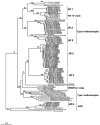Methane-oxidizing bacteria in a California upland grassland soil: diversity and response to simulated global change
- PMID: 15870356
- PMCID: PMC1087552
- DOI: 10.1128/AEM.71.5.2642-2652.2005
Methane-oxidizing bacteria in a California upland grassland soil: diversity and response to simulated global change
Abstract
We investigated the diversity of methane-oxidizing bacteria (i.e., methanotrophs) in an annual upland grassland in northern California, using comparative sequence analysis of the pmoA gene. In addition to identifying type II methanotrophs commonly found in soils, we discovered three novel pmoA lineages for which no cultivated members have been previously reported. These novel pmoA clades clustered together either with clone sequences related to "RA 14" or "WB5FH-A," which both represent clusters of environmentally retrieved sequences of putative atmospheric methane oxidizers. Conservation of amino acid residues and rates of nonsynonymous versus synonymous nucleotide substitution in these novel lineages suggests that the pmoA genes in these clades code for functionally active methane monooxygenases. The novel clades responded to simulated global changes differently than the type II methanotrophs. We observed that the relative abundance of type II methanotrophs declined in response to increased precipitation and increased atmospheric temperature, with a significant antagonistic interaction between these factors such that the effect of both together was less than that expected from their individual effects. Two of the novel clades were not observed to respond significantly to these environmental changes, while one of the novel clades had an opposite response, increasing in relative abundance in response to increased precipitation and atmospheric temperature, with a significant antagonistic interaction between these factors.
Figures





References
-
- Alzerreca, J. J., J. M. Norton, and M. G. Klotz. 1999. The amo operon in marine, ammonia oxidizing γ-proteobacteria. FEMS Microbiol. Lett. 180:21-29. - PubMed
-
- Baker, P. W., H. Futamata, S. Harayama, and K. Watanabe. 2001. Molecular diversity of pMMO and sMMO in a TCE-contaminated aquifer during bioremediation. FEMS Microbiol. Ecol. 38:161-167.
-
- Blake, D. R., and F. S. Rowland. 1988. Continuing worldwide increase in tropospheric methane, 1978 to 1987. Science 239:1129-1131. - PubMed
Publication types
MeSH terms
Substances
Associated data
- Actions
- Actions
LinkOut - more resources
Full Text Sources
Other Literature Sources

